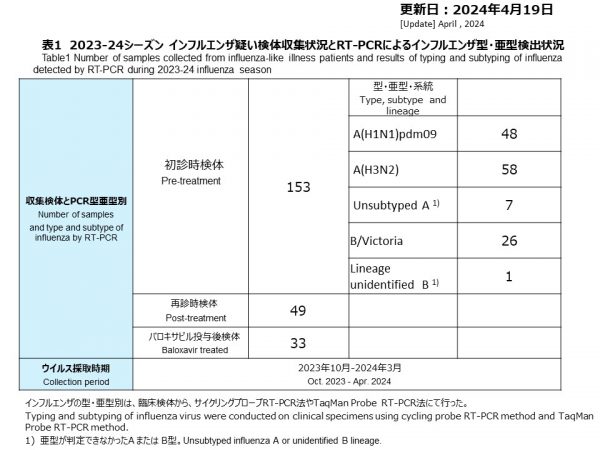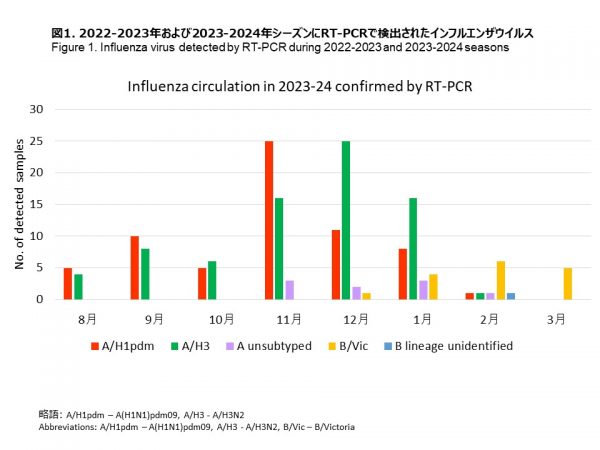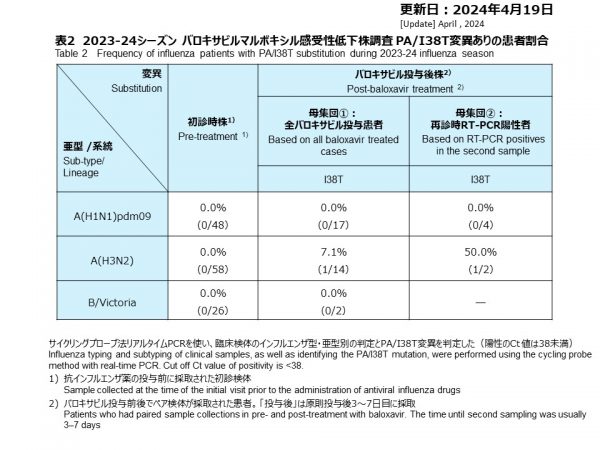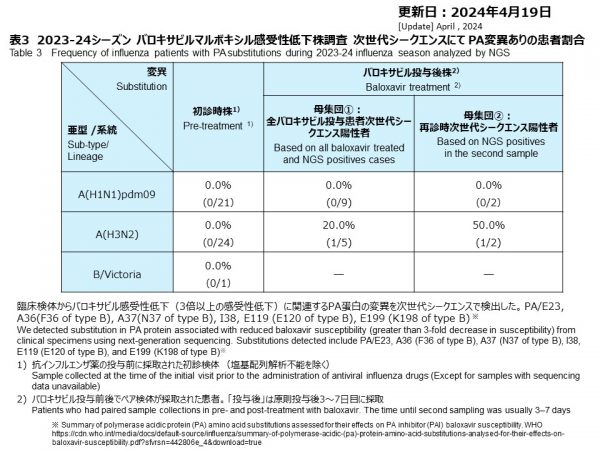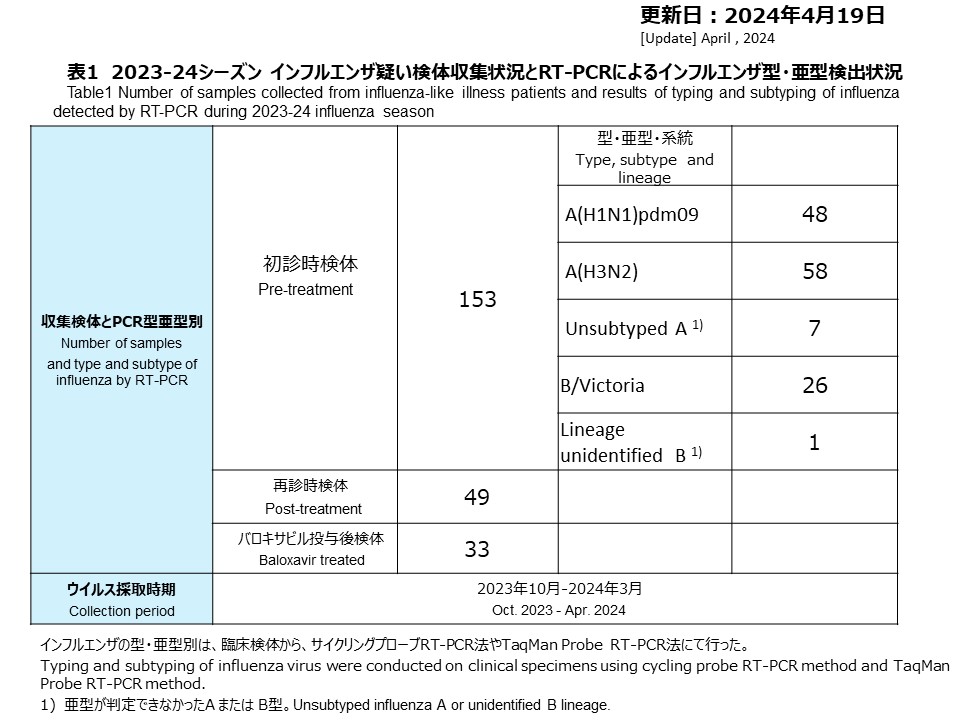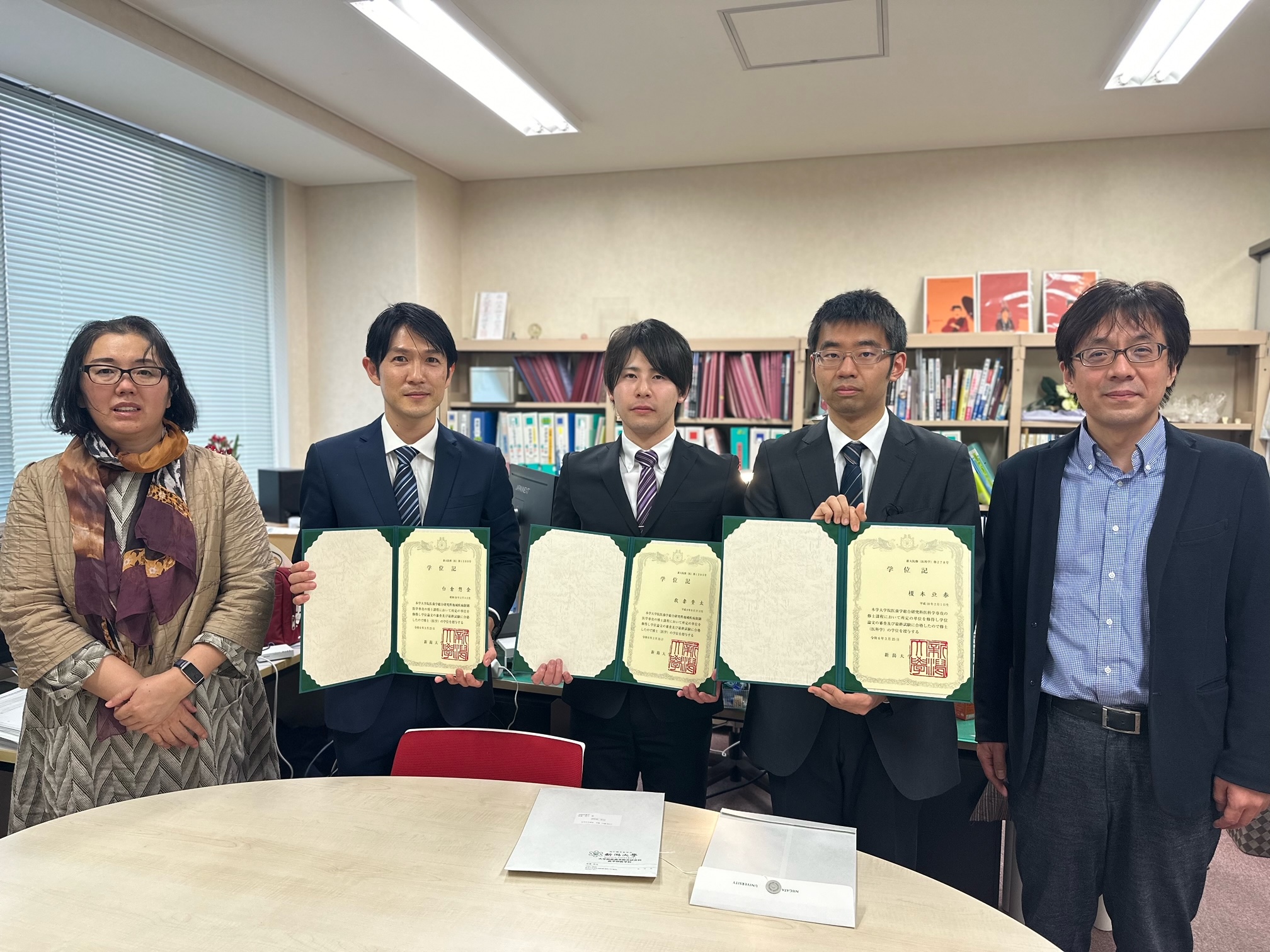2024年4月19日 抗インフルエンザ剤感受性低下株調査の結果
結果の概要
2024年4月19日時点
2023年10月から2024年2月にかけて、合計153件の初診時検体が採取されました。再診時検体は49件採取され、うち33件はバロキサビル投与後に採取されました(表1)。
2023年10月以降、インフルエンザA(H1N1)pdm09を48件、A(H3N2)を58件、インフルエンザA型(亜型が特定不能)を7件、B/ビクトリアを26件、インフルエンザB型(系統が特定不能)を1件検出しました(表1,図1)。今シーズンはA(H1N1)pdm09、A(H3N2)およびB/ビクトリアが検出されました。A(H1N1)pdm09とA(H3N2)が8月頃から同時流行し、11~12月にピークがありました。A型はその後減少し、1月からB/ビクトリアが増え、2月以降はB型が流行の主流となりました。
インフルエンザウイルスのPA蛋白38位がイソロイシンからスレオニンに変異したウイルス(PA/I38T変異株)は、バロキサビルに対して感受性低下を示すと言われています。このPA/I38T変異株を特異的に検出するリアルタイムPCR法(サイクリンブプローブ法)を採取された検体全てに実施しました。
リアルタイムPCR法により、PA/I38T変異を検出したところ、抗インフルエンザ薬投与前のA(H1N1)pdm09の48株、A(H3N2)の58株、B型の26株のいずれにおいてもPA/I38T変異は検出されませんでした(表2)。
バロキサビル投与後に採取された検体(再診時検体)は33件でした(表2)。17件がA(H1N1)pdm09で、うち4件がPCR陽性でしたが、PA/I38T変異は検出されませんでした。A(H3N2)は14件で、2件がPCR陽性で、うち1件にPA/I38T変異が検出されました。バロキサビル投与後のPA/I38T変異株の出現頻度は7.1%でした( 1/14)。B/Victoriaは2件でしたが、再診のPCR結果では全て陰性でした。
[PA遺伝子解析]
次世代シークエンシング(NGS)を実施した初診時検体46件は、A(H1N1)pdm09が21件、A(H3N2)が24件、B型が1件で、バロキサビルに対する感受性低下を示すと報告されたPA変異はすべての検体にありませんでした。
バロキサビル投与後に採取された検体(再診時検体)について、NGSで解析できたのは、A(H1N1)pdm09が2件、A(H3N2)が2件でした。A(H1N1)pdm09にはバロキサビルに対する感受性低下を示すと報告された変異は検出されませんでした(0.0%, 0/2)。A(H3N2)の1件にはPA/I38T変異が検出されました(20.0%, 1/5)(表3)。
[NA遺伝子解析]
NGSを実施した初診時検体46検体は、オセルタミビルを含むNA阻害剤に対する感受性低下を示すと報告されたNA変異はすべての検体にありませんでした。オセルタミビル投与後に採取された検体A(H1N1)pdm09の7件、A(H3N2)の5件、B型の1件には、NA阻害剤に対する感受性を低下させる変異はNA遺伝子に検出されませんでした(表4)。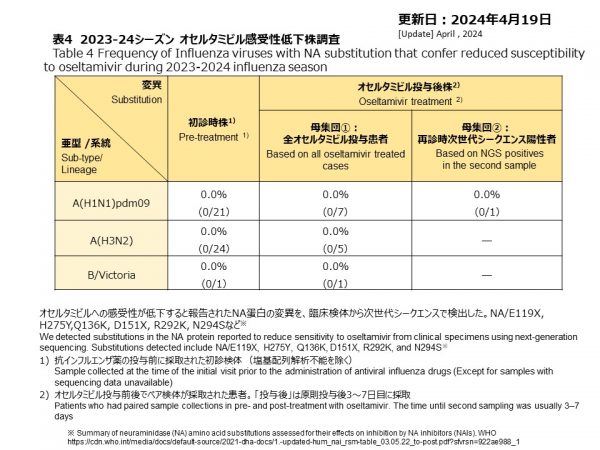
Summary of Results.
As of April 19, 2024
From October 2023 to March 2024, a total of 153 initial visit specimens were collected. There were 49 specimens collected at follow-up visits (second visits), of which 33 were collected after administration of baloxavir (Table 1).
Since October 2023, 48 cases of Influenza A(H1N1)pdm09, 58 cases of A(H3N2), 7 cases of Influenza A (subtype unidentified), 26 case of B/Victoria and 1 case of lineage unidentified B were detected (Table 1 and Figure 1). This season, A(H1N1)pdm09, A(H3N2), and B/Victoria were detected. A(H1N1)pdm09 and A(H3N2) were simultaneously prevalent from around August, with a peak in November and December. Type A subsequently declined, B/Victoria increased from January, and type B became the mainstay of the epidemic from February onward.
A virus with a substitution at position 38 of the PA protein, from isoleucine to threonine (PA/I38T mutation), is reported to confer reduced sensitivity to baloxavir. We implemented a real-time PCR method (cycling probe method) specifically designed to detect this PA/I38T mutation on all samples.
None of the 48 of A(H1N1)pdm09, 58 of A(H3N2), and 26 of influenza B/Victoria collected before administration of antiviral influenza drugs showed the presence of the PA/I38T mutation by real-time PCR (Table 2).
There were 33 specimens collected after administration of baloxavir (follow-up visit specimens) (Table 2). Among these, 17 were A(H1N1)pdm09, with 4 testing PCR positive, but the PA/I38T substitution was not detected. There were 14 cases of A(H3N2), with two testing PCR positive; interestingly, one was PA/I38T positive. The frequency of PA/I38T emergence after treatment with baloxavir was 7.1% (1/14). Additionally, two B/Victoria cases tested negative for PCR on the 2nd visit. [PA Gene Analysis]
Forty-six initial visit specimens were subjected to next-generation sequencing (NGS), with 21 cases of A(H1N1)pdm09, 24 case of A(H3N2), and 1 case of type B. None of first visit specimen had any PA substitution, with reduced susceptibility to baloxavir.
Two influenza A(H1N1)pdm09 and two A(H3N2) positive samples, derived from post-baloxavir-treated patients, underwent NGS, No PA-variants was found among A(H1N1)pdm09 strains (0.0%, 0/2). One influenza A(H3N2)-infected, post-baloxavir-treated case, with PA/I38T substitution was confirmed in the PA protein by NGS (50%, 1/2) (Table 3).
[NA Gene Analysis]
Same 46 strains analyzed for NA substitutions, affecting sensitivity to neuraminidase inhibitors (NAIs). NGS results showed no substitution in the NA gene affecting sensitivity to NAIs in the 46 prior to treatment cases of 7 A(H1N1)pdm09, 5 A(H3N2) and 1 B/Victoria (Table 4). One post-oseltamivir-treated sample was sequenced and no any variants, inhibiting NAIs was confirmed (Table 4).


